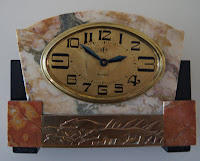Then in the early 1930's, aa new material came onto the market that would revolutionize manufacturing: Bakelite. As Jaz preferred to customize its components, it named the bakelite used in its model Jazolite. Coinciding with new casings was the new major technical advancement of an 8 - day movement to replace the 30 hour movement. New clocks now only required winding every week instead of every day.
New alarm clock models began filling the shelves and Jaz strongly promoted the idea of a clock in every room in the house including the kitchen.
 |
| Berric model 1935 |
 |
| Lotic model 1934 |
 |
| Lorric Model 1937 |
 |
| Persic model 1938 |
 |
| Lucic Model 1935 |
Every model produced came in different dials, with luminous or non luminous hands but the same finish that could be kept pristine with a simple wipe of a cloth.
In 1934 they produced a large mantle sized clock using a new type of movement that was almost silent and did not include an alarm . The Silentic had something unique: a tiny triangle in the 12 indicating that the clock needed to be wound when it showed red.
 |
| Gotic model 1931 |
 |
| Janic model 1934 |
 |
| Romic model 1931 |
While bakelite was widely used in a large selection of clocks, other materials (brass, chrome and porcelaine) continued to be utilized in an ever expanding line of models.
The Romic (left) was one of the most popular models. Its use of shiny chrome, the semi-circular design, the 'beehive' hands and the luminous numbers appealed to the Art Deco style.
With its expanding markets, Jaz began print advertising and to distinguish it from its competitors, most of its ads were in black and red on a white background.
Jaz was the leader in the number of styles, models and overall sales until WWII, when materials became rarer and workers were drafted into military service.
Until 1941, all Jaz clocks had the word JAZ stamped on the dial above the 6.
When the Third Reich invaded France, the Nazis objected to the use of the word JAZ because it was interpreted as a symbol of 'decadent American music'. To circumvent their objection (and possible closure of the production plants) the directors explained that the name JAZ referred to a small bird, the Jaseur Boréal and bore no relation to the music. As a result, all clocks manufactured after 1942 had a little bird stamped above the Jaz name. The bird's tail was directed downward and this was used until 1967, when the bird's tail was then directed upward.
After 1975, the bird disappeared and the name JAZ now appeared under the number 12.


































